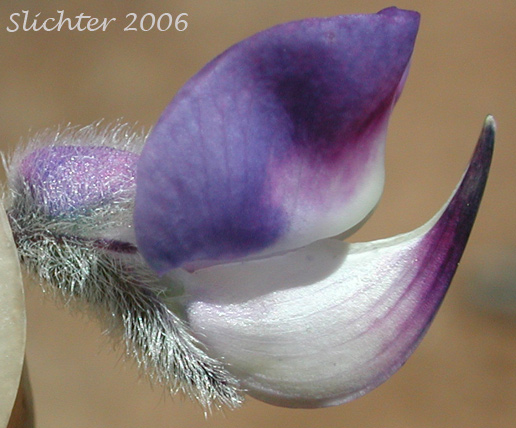 The photo at right shows a close-up sideview of the flower of Bingen lupine as
seen atop the Columbia Hills to the northeast of The Dalles, OR..........May
14, 2006. The wing petals have been removed to show the keel, with the tip of
the keel narrowing abruptly and held nearly erect.
The photo at right shows a close-up sideview of the flower of Bingen lupine as
seen atop the Columbia Hills to the northeast of The Dalles, OR..........May
14, 2006. The wing petals have been removed to show the keel, with the tip of
the keel narrowing abruptly and held nearly erect.
Bingen lupine is a perennial lupine to 10 dm tall. It tends to have basal leaves present during flowering, with the lower leaf petioles 3 to 5 times longer than the leaflet blades, while the upper stem leaves may have petioles shorter than the blades. The compound palmate leaves may have from 9 to 11 narrlw, oblanceolate leaflets with acute tips. The leaflets may be hairless above and sparsely to very hairy beneath, or they may be equally very haired on both surfaces. Variety subsaccatus tends to have pubescence on both leaflet surfaces.
The flowers are bluish or purple (variety sulphureus has yellow flowers) and found on 6 to 15 cm long racemes (usually less than 10 cm in variety subsaccatus. The calyx is silky and it is asymetrical although it isn't spurred. The upper lip of the flower is bidentate, while the lower is entire. The banner isn't reflexed very much from the wings or keel.
Bingen Lupine: Lupinus bingensis - Stems with appressed hairs. The inflorescence is more open and pyramidal
Soft Lupine: Lupinus mollis - Stems with spreading hairs. The inflorescence is fairly dense and more oval or cylindrical in shape.
Prairies and sagebrush desert from the foothills into the lower mountains.
Sulphur Lupine ranges from British Columbia south along the eastern edge of the Cascades to California, and ranges eastward to Idaho.
It may be found down the Columbia River to the Willamette River Valley, and into southwestern Washington.